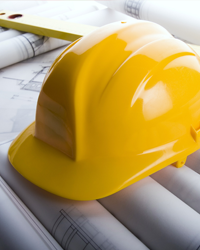Often, the construction phase of a club renovation project can be aptly described as short  term pain for long term gain, a necessary evil to achieve improved business outcomes.
term pain for long term gain, a necessary evil to achieve improved business outcomes.
All the steps leading up to construction tend to be fun and challenging and rewarding in equal measure. Developing board consensus and obtaining approvals can be testing, as can the finance approvals process. The design development stage tends to be rewarding as clubs communicate with architects and builders and develop a vision for the club. The process of gaining regulatory approvals from various tiers of government, while sometimes testing and arduous, are undertaken with vigour as the big picture goal of a new club is squarely in focus.
And even the early phases of construction can be quite exciting. The knowledge that the building project is underway and that the club (or sections of it) will be brand new in 6-12 months tends to hearten management and board members.
But what about the effect that the 6-12 month construction project can have on the team at the coalface? Noise, dust, temporary facilities to work in, members often voicing their discontent regarding the disruption to normal service, maybe even a reduction in hours for casuals in line with a decline in trade – these are all factors that can inhibit a club’s capacity to maximise the benefits of their major renovation project. What good is a brand new fit-out if the people working in are construction-fatigued? Clubs need to invest in their people while they invest in their facilities.
Here’s five reasons why club-building time should also be people-building time.
- Making the business plan ‘stack up’
When deciding to spend millions of dollars on a renovation, there is the need to develop a business case for the capital spend. Even if a club hasn’t completed a detailed financial feasibility, it would be reckless to spend millions of dollars of members’ funds without developing a basic business case first. Typically, when selling their proposal, management tend to push the ‘best case scenario’ to the board and the bank, and these are the expectations that are set. Managers have to achieve the version of the business case that supports their assumptions about outperforming the local catchment’s ADR by 15% and growing beverage 10% per annum when on premises beverage consumption has been in decline for a decade. Tough to do with a demotivated team.
If a club wishes to achieve the ‘optimistic’ or ‘best case scenario’, more than a slick fit-out is required. Only skilled and qualified management team with a well-considered operating plan can deliver an experience that matches the quality of the fit-out.
- Making the quality of the experience match the quality of the facility
It’s not uncommon in 2014 to hear of clubs investing four or six or even ten million dollars on a renovation project which is predominantly fit-out of existing facilities and includes only a small component of additional ground floor area. When we consider those numbers on a $/m2 basis, it can be staggering to calculate that clubs are investing upwards of $4,000/m2 and hardly expanding their footprint.
Even the most opulent fit-out won’t deliver results if the staff working in the club call diners ‘darl’, take 4 minutes to issue a payout, make a 110oC flat white, can’t pour a beer to save their lives, and can’t be bothered cleaning the DOSA. A luxe finish will raise expectations, a club’s staff members need to be equipped with the ‘hospitality basics’ skill set and be suitably motivated to deliver above expectation results.
- Heightened member expectations
Remember, a club’s balance sheet doesn’t refer to owners’ equity; it refers to members’ funds. And that’s how members perceive their club. If boards and management wish to invest millions of dollars of members’ funds in a building project, it had damn well better benefit members (just ask them). A stylish new restaurant or bar or state of the art gaming room might impress a club member with its newness initially, but that warm glow will fade promptly if the staff member serving them isn’t smiling at least as brightly as the shiny new chrome finish on the beer font.
- Opportunities to create first impressions with new members
If a club’s business case forecasts revenue growth as an outcome of their major renovation project, attracting new members will be one of the keys to achieving this. And experience shows that a major refurbishment at a pub or club tends to generate a great deal of interest in the local market.
These new patrons, hopefully now members, will judge their new club initially on the great new facilities but ultimately on the quality of products and service they receive. Only a well-trained and motivated team can create this type of lasting first impression.
- Reduction in trade, a reduction in productivity
Often the disruption that results from a renovation leads to a decline in revenue. The consequences of this can often include lost hours for casual staff, resulting in reduced morale, reduced work performance and declining productivity.
Ask ten economists to provide a list of factors that improve productivity and you’ll receive ten different lists. However, rather than focussing on what’s different, focus on the common elements of the ten lists and you’ll find two recurring productivity-enhancing themes:
- Invest in health
- Invest in education
A renovation project is an opportunity to invest in both.
- Invest in your team’s mental health by engaging them in planning workshops to brainstorm the new customer service standards to impress your members.
- Invest in education by enrolling your managers in a Diploma Course. At the end of your 12-month building project you can host a graduation night for those managers to celebrate their success and enjoy a boost in attitude to match their newly enhanced skillset.
- Host a series of morale boosting events. Celebrate the conclusion of your renovation with the team at a customer service breakfast to launch your service standards and give the team the lift they need so that they can shine when working in the new club.
- Engage in a Duty Manager Development program in the lead up to the conclusion of your renovation. Management teams who’ve been actively engaged in planning how to operate the new club will operate at a much higher level of skill, competence and care than they otherwise might.
Ultimately, it’s about making a tiny investment in people with the aim of boosting returns from a major investment in the club. Even if the budget for staff training and team building was as little as 0.25% to 0.5% of the project expenditure, boards and management will achieve their ‘optimistic’ scenario from their business case and maximise their ROI if the whole team is on board to drive the new venue to maximise results.
Club Training Australia and DWS Hospitality Specialists can provide both accredited training and tailored team development solutions to assist your club to maximise the returns from your major capital investment. Call to speak with the team at DWS on 07 3878 9355 or email us at info@dws.net.au.



